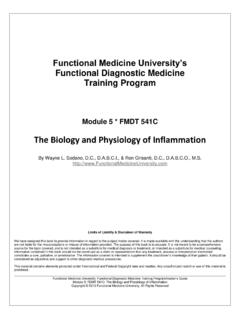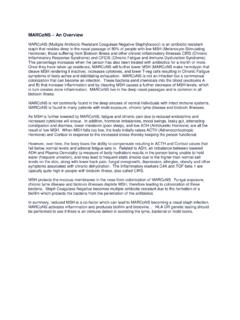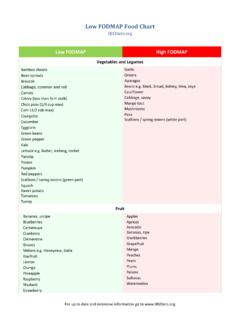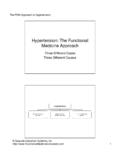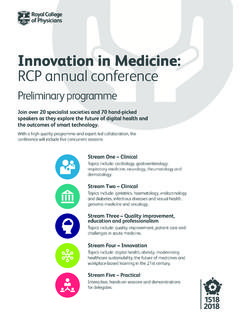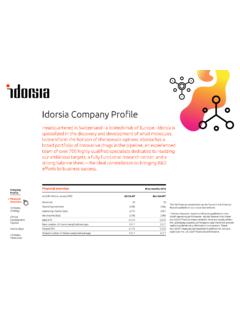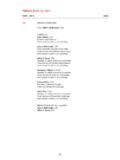Transcription of Cardiovascular Disease: A Comprehensive …
1 functional medicine University s functional Diagnostic medicine Training Program Module 5 * FMDT 545A Cardiovascular disease : A Comprehensive approach to evaluation and Management By Wayne L. Sodano, , , & Ron Grisanti, , , Limits of Liability & Disclaimer of Warranty We have designed this book to provide information in regard to the subject matter covered. It is made available with the understanding that the authors are not liable for the misconceptions or misuse of information provided. The purpose of this book is to educate. It is not meant to be a Comprehensive source for the topic covered, and is not intended as a substitute for medical diagnosis or treatment, or intended as a substitute for medical counseling. Information contained in this book should not be construed as a claim or representation that any treatment, process or interpretation mentioned constitutes a cure, palliative, or ameliorative.
2 The information covered is intended to supplement the practitioner s knowledge of their patient. It should be considered as adjunctive and support to other diagnostic medical procedures. This material contains elements protected under International and Federal Copyright laws and treaties. Any unauthorized reprint or use of this material is prohibited. functional medicine University; functional Diagnostic medicine Training Program/Insider s Guide Module 5: FDMT 545A: Cardiovascular disease : A Comprehensive approach to evaluation and Management Copyright 2010 functional medicine University, All Rights Reserved functional medicine University s functional Diagnostic medicine Training Program Module 5: FDMT 545A: Cardiovascular disease : A Comprehensive approach to evaluation and Management By Wayne L. Sodano, , , & Ron Grisanti, , , 1 Contents 2010 Update from the American Heart Association 2 Artery Anatomy 3 Vein Anatomy 3 The Atherosclerosis Timeline 4 Pro-Inflammatory Stimuli That Trigger Endothelial Cells 7 Vasoconstrictors and Vasodilators 10 The Biomarkers of Arterial Cell Wall Inflammation 10 Endothelial Activation/Dysfunction in Arthrosclerosis 11 Infectious Agents as Triggers of Inflammation in Atherosclerosis 12 Peripheral Artery disease (PAD) 13 Clinical Implications of PAD 13 Typical vs.
3 Atypical Symptoms in Patients With Symptomatic PAD 14 Diagnosis of Peripheral Arterial disease 14 Physical Exam of PAD 15 The Edinburgh Claudication Questionnaire 15 Prevention 16 functional medicine approach : Treatment of PAD 17 Diagnostic Studies for the evaluation of Venous and Arterial disease 17 Review of Doppler Waveforms 18 Examples of ABI and Pulse Volume Record 20 Hypertension 20 Renin-Angiotensin-Aldosterone System 22 Hormone and Other Chemical Messengers That Affect Blood Pressure 23 evaluation of Patients with Documented Hypertension 24 Heavy Metal Toxicity 25 Laboratory Tests 25 Lipoprotein Structure 26 Advanced functional medicine Testing 30 Minerals 32 Specific Cardiovascular disease Treatment Considerations 34 Comparison Of Mechanism And functional Effects Of Magnesium And Statin Pharmaceuticals 35 Botanical Considerations for Cardiovascular disease 37 In Summary 38 References 39 (Required Reading).
4 The Atherosclerosis Time-Line and the Role of the Endothelium. This article may be downloaded from the FMU on-line library. functional medicine University s functional Diagnostic medicine Training Program Module 5: FDMT 545A: Cardiovascular disease : A Comprehensive approach to evaluation and Management By Wayne L. Sodano, , , & Ron Grisanti, , , 2 2010 Update from the American Heart Association The American Heart Association, in conjunction with the Centers for disease Control and Prevention, the National Institutes of Health, and other government agencies, gathered statistical information on heart disease , stroke, other vascular diseases and their risk factors and present them in a yearly update. A summary of the 2010 update from the American Heart Association concluded the following: The 2006 overall death rate for CVD was per 100,000 (1 of every deaths in the ) 2300 Americans die of CVD each day (average of 1 death every 38 seconds) Coronary heart disease caused approximately 1 of every 6 deaths in the in 2006 In 2006 1 in death certificates mentioned heart failure Data from the National Health and Nutrition Examination Survey (NHANES) 2003-2006 indicated that of US adults 20 years of age have hypertension.
5 Despite four decades of progress, in 2008, among Americans 18 years of age, of men and of women continued to be cigarette smokers. In grades 9 through 12, of male students and of female students reported tobacco use. In 2006, an estimated 17,200,000 Americans had diagnosed diabetes, representing of the adult population. A further 6,100,000 had undiagnosed diabetes, and 29% had prediabetes, with abnormal fasting glucose levels. The estimated prevalence of overweight and obesity in US adults was in 2006 Among children 2 to 19 years of age, are overweight and obese Fifty-nine percent of adults who responded to the 2008 National Health Interview Survey reported engaging in no vigorous activity functional medicine University s functional Diagnostic medicine Training Program Module 5: FDMT 545A: Cardiovascular disease : A Comprehensive approach to evaluation and Management By Wayne L.
6 Sodano, , , & Ron Grisanti, , , 3 The intima surrounds the lumen of the blood vessels and is made up of a single continuous lining of endothelial cells. The endothelial cells have the capacity to perform a significant amount of metabolic reactions. The intact endothelium synthesizes regulators of thrombosis like prostacyclin, plasminogen activator, and heparin-like molecules. It produces prothrombotic molecules, and modulates blood flow and vascular reactivity. It produces vasoconstrictors like endothelin and angiotensin-converting enzyme (ACE), as well as, vasodilators, such as, nitric oxide and prostacyclin. The intimal endothelium also regulates immune and inflammatory reactions through elaboration of cytokines, adhesion molecules, and histocompatibility antigens. The media is composed of smooth muscles that dilate and constrict to accommodate blood flow and blood pressure. The media is sandwiched between an inner (internal) and outer (external) layer of elastic membrane.
7 The arteries must respond to the variations that cardiac systole and cardiac diastole. The anatomy and size of the arteries vary according to their distance from the heart. The aorta and its immediate branches (pulmonary, carotid, and iliac) are highly elastic. The large arteries will course into medium-sized (muscular) arteries, like the coronary and renal arteries. The elastic recoil and smooth muscle contraction and relaxation in the media of large and medium sized arteries propagate arterial pulsatile flow. The medium arteries divide into smaller arteries and even smaller arterioles. Resistance to blood flow occurs primarily in the arterioles. Blood flows from the arterioles to the capillaries. The diameter of the capillaries is about 7 to 8 micron, about the size of a red blood cell. The capillaries have an endothelia lining, but are devoid of the tunic media. functional medicine University s functional Diagnostic medicine Training Program Module 5: FDMT 545A: Cardiovascular disease : A Comprehensive approach to evaluation and Management By Wayne L.
8 Sodano, , , & Ron Grisanti, , , 4 Unlike arteries, veins are thin-walled and highly distensible, with the capacity for up to two-thirds of circulating blood flow. The venous intima consists of a non-thrombogenic endothelium. Protruding into the lumen of the veins are valves that promote unidirectional flow. The media contains circumferential rings of elastic tissue and smooth muscle that change vein caliber in response to changes in venous pressure. The Atherosclerosis Timeline functional medicine University s functional Diagnostic medicine Training Program Module 5: FDMT 545A: Cardiovascular disease : A Comprehensive approach to evaluation and Management By Wayne L. Sodano, , , & Ron Grisanti, , , 5 The pathological effects of atherosclerosis occur over decades, with injury to the endothelial cells initiating the process. (Required Reading): The Atherosclerosis Time-Line and the Role of the Endothelium.
9 This article may be downloaded from the FMU on-line library. The systemic manifestations of atherosclerosis include: TIA Ischemic stoke STEMI (ST segment elevation myocardial infarction) NSTEMI (Non-ST segment elevation myocardial infarction) Unstable angina pectoris Renovascular hypertension Erectile dysfunction Claudication Critical limb ischemia, rest pain, gangrene, amputation The endothelial cells normally resist leukocyte adhesion. Normal endothelial cells produce nitric oxide from arginine via nitric oxide synthase. Nitric oxide acts as a vasodilator by increasing smooth muscle cell cyclic guanosine monophosphate levels, while at the same time inhibiting platelet aggregation and smooth muscle proliferation4. Abnormal vasomotor responses have been attributed to reduced bioavailability of endothelium-derived relaxing factor(s), such as nitric oxide, as a result of rapid inactivation of nitric oxide by oxidant stress or excessive generation of asymmetric dimethylarginine (ADMA) and/or increased production of vasoconstrictors4.
10 functional medicine University s functional Diagnostic medicine Training Program Module 5: FDMT 545A: Cardiovascular disease : A Comprehensive approach to evaluation and Management By Wayne L. Sodano, , , & Ron Grisanti, , , 6 ADMA is a naturally occurring amino acid produced by methylation of specific arginine residues of certain cellular proteins. Most of the proteins that have been found to undergo significant arginine methylation are found in the nucleus. Nitric oxide cannot easily be directly measured, but the inhibitor of its formation, ADMA can be. Elevated ADMA has been associated with various Cardiovascular risk factors such as lipid disorders, insulin resistance, diabetes, hypertension, PAD, renal failure, and erectile dysfunction. Factors contributing to elevated ADMA include increased oxidative stress and folic acid insufficiency. Lowering ADMA and restoring nitric oxide production can be achieved by decreasing oxidative stress, increasing antioxidants, and supplementing with L- arginine (3-6 grams/day), tetrahydrobiopterin, vitamin C, folic acid, and B-complex as well as establishing optimal essential fatty acid levels.
